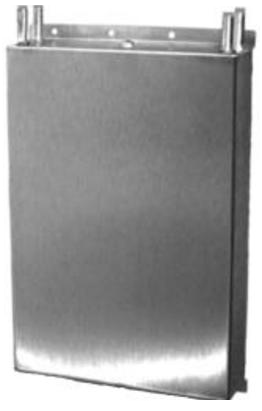Is a Cold Plate System Right For You?
Understanding Cold Plate Systems
What is a Cold Plate refrigeration system?
A cold plate (also called a holdover plate) is a large tank inside your refrigerator or freezer box filled with a solution that freezes and melts out at a temperature lower than water (20 degrees for a refrigerator, -10 degrees for a freezer). Refrigerant tubing is coiled inside the tank so that the as the refrigerator runs the tubing is cold enough to freeze the solution solid. After the solution is frozen solid, the compressor shuts off and the cold plate acts as a large ice block, slowly melting back to a liquid as it removes heat from the box. Depending on the size of the cold plate and the heat load of the box, the cold plate can provide cooling for 24 hours or more. Basically it is a thermal battery, storing cold when excess power is available, and providing cooling when power is not available. To be able to freeze the cold plate solid in a few hours, a large capacity high amp draw 120V compressor is usually used (although we do offer a high capacity 12V compressor option with variable speed, typically for refrigerator cold plates only).
This differs from a standard evaporator type system, where a low amp draw DC compressor cycles on and off several times an hour, pulling power from your batteries to maintain box temperatures.
Example: A small 12-volt compressor removes two hundred BTUs of heat per hour. In a cold plate system, a large compressor can remove as much as 4000 BTUs per hour. The energy stored in cold plates then provides cooling for 24 hours or more.
The purpose of installing a cold plate system over a standard evaporator is to take advantage of surplus power when it is available. When you are motoring out, running your generator, generating solar power during midday or plugged in to shore power, there is more power available than is being used to charge your batteries and power your boat. Depending on your generator, you may be using only 20% of its electrical capacity when running it to charge your batteries. This means there is surplus power that would be otherwise wasted, and can instead be used to power a high capacity compressor, which will draw a fairly high level of current to freeze the cold plate solid within a few hours. Then once you've shut your engines off to sail, or when you drop anchor to spend the night, your refrigerator or freezer stays cold without any draw from your battery bank.
Cold plate systems will not be the best option for everyone. There are some disadvantages to cold plate systems, depending on your specific application and situation. You will need to have surplus power available for 1 to 1.5 hours twice a day. You will need to have a large enough box to fit the large cold plate tank inside. Usually freezers require two cold plates, which can take up a significant amount of space in the freezer. On many boats the top load access hatch may be too small to fit the cold plate tank through, making installation difficult or impossible. We can manufacture our cold plates to a small enough size to fit through the hatch, where other companies only carry stock sizes. Cold Plate systems are more expensive than traditional evaporator type systems, and you should expect to pay about twice as much. Installation of Cold Plates can also be more difficult and costly than evaporator systems. Cold plates can be the best choice if you have a limited amount of amp hours in your battery bank, although spending the money to add more batteries or upgrade your battery charger may be more advantageous in the long run.
We use refrigerant R-134a in our refrigerator cold plates. It’s boiling point of -15°F makes it ideal for refrigerators or warm temperature freezer cold plates systems. R404A, with a boiling point of -50°F, is used in our freezer models because of its excellent performance at low temperatures. Freezing temperatures of -15 to -20 degrees are possible. R404A increases the temperature differential between the solution and refrigerant, decreasing the freezing time 20-30% compared to other refrigerants.
While we can make cold plates for refrigerator applications, our recommendation is that cold plate systems work best for freezers, and standard evaporator systems work best for refrigerators. It can be difficult to maintain consistant refrigerator temperatures with a cold plate due to the lack of control. The cold plate will be absorbing the same amount of heat whether the ambient temperature is 90 degrees or 50 degrees, so there is the possibility of freezing the food products when the ambient temperature drops at night. Freezers are more forgiving of these temperature fluctuations.
Surface area of tubing inside a plate is critical to efficiency - the more you have the faster the solution will freeze. Most manufacturers use 1/2 inch or 5/8 inch outside diameter tubing. We've found these sizes to be too large. In refrigeration systems, refrigerant and oil continuously circulate through the system. When tubing is large in diameter, refrigerant moves slowly which makes the compressor work excessively. To solve this problem and increase efficiency, we use a distribution system comprised of multiple passes of either 1/4 inch or 5/16 inch tubing plumbed in parallel. This method can double the surface area of tubing inside the plate while maintaining the proper velocity of refrigerant.
Condenser: Water cooled, air cooled or both?
We build cold plate systems that use air, water or a combination to remove heat from the plate. An air-cooled compressor mounted in a well-ventilated area performs quite well. Although running longer per day than water-cooled models, they are less complex mechanisms and therefore more trouble free. A water-cooled compressor model offers outstanding performance in a hot or non-ventilated compartment, however it does require a water pump and the potential problems associated with that. A combination air-and-water-cooled compressor provides excellent performance and reliability in case of water pump or fan failure.
So now that you know a bit more about Cold Plate systems and how they work, its time to decide if a cold plate system is right for you.
To summarize, Cold Plates may be the best choice if any of the following applies to you:
- You have a limited battery bank
- You run your generator for at least two hours a day to charge your batteries
- You typically keep your boat connected to shore power and mostly take day trips
- You motor out of harbor for an hour or two a day and you have a large enough alternator to charge your batteries and power the compressor
Cold Plates may NOT be the best choice if any of the following applies to you:
- You typically take long trips away from shore power
- You run your generator to supply power to other 120V loads such as air conditioners
- You have an adequately sized battery bank
- You are looking for the most economical refrigeration option
We would be happy to discuss your particular situation and application to give our recommendation as to whether a Cold Plate system is right for you, just Contact Us.
Once we've determined a cold plate system is right for you, we will design the most efficient system possible by properly sizing the cold plate as well as the compressor for your particular application. To do this we need to determine the following:
- Inside or outside dimensions of the box
- Amount of insulation
- Desired temperature inside the box
- Outside air temperature
- Desired run time per day
- Type(s) of power available
- Amount of ice or food to be refrigerated, if any
Please fill out our Cold Plate Contact Form to discuss further options and to get a price quote for a Cold Plate System.


